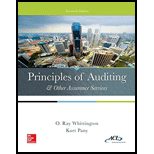
Principles of Auditing & Other Assurance Services (Irwin Accounting)
20th Edition
ISBN: 9780077729141
Author: Ray Whittington, Kurt Pany
Publisher: McGraw-Hill Education
expand_more
expand_more
format_list_bulleted
Question
Chapter 5, Problem 48P
a.
To determine
Explain audit risk.
b.
To determine
Explain the components of inherent risk, control risk, and detection risk.
c.
To determine
Explain the interrelationship among the given components.
d.
To determine
Explain the component which is completely a function of the sufficiency of the evidence gathered by the auditors’ procedures.
Expert Solution & Answer
Trending nowThis is a popular solution!

Students have asked these similar questions
The Snape Corporation has the following data for 2014:
Selling price per unit $10
Variable costs per unit $6
Fixed costs
Units sold
$20,000
12,000
Snape's 2014 operating leverage is:
a) 0.50
b) 2.00
c) 4.00
d) 1.71
Please provide the solution to this general accounting question using proper accounting principles.
none
Chapter 5 Solutions
Principles of Auditing & Other Assurance Services (Irwin Accounting)
Ch. 5 - Prob. 1RQCh. 5 - Prob. 2RQCh. 5 - Prob. 3RQCh. 5 - Distinguish among routine, nonroutine, and...Ch. 5 - Prob. 5RQCh. 5 - Prob. 6RQCh. 5 - Prob. 7RQCh. 5 - As part of the verification of accounts receivable...Ch. 5 - Prob. 9RQCh. 5 - When in the course of an audit might the auditors...
Ch. 5 - Prob. 11RQCh. 5 - Prob. 12RQCh. 5 - Prob. 13RQCh. 5 - Prob. 14RQCh. 5 - Prob. 15RQCh. 5 - Prob. 16RQCh. 5 - Prob. 17RQCh. 5 - What disclosures should be made in the financial...Ch. 5 - Prob. 19RQCh. 5 - Prob. 20RQCh. 5 - Prob. 21RQCh. 5 - Prob. 22RQCh. 5 - Prob. 23RQCh. 5 - Prob. 24RQCh. 5 - Prob. 25RQCh. 5 - Prob. 26RQCh. 5 - Prob. 27RQCh. 5 - Prob. 28RQCh. 5 - Prob. 29RQCh. 5 - I have finished my testing of footings of the cash...Ch. 5 - Prob. 31RQCh. 5 - Prob. 32RQCh. 5 - Financial statements contain a number of...Ch. 5 - Prob. 34QRACh. 5 - In an audit of financial statements, the auditors...Ch. 5 - Prob. 36QRACh. 5 - Prob. 37QRACh. 5 - Prob. 38QRACh. 5 - Prob. 39QRACh. 5 - Prob. 40QRACh. 5 - Prob. 41QRACh. 5 - Prob. 42QRACh. 5 - Prob. 43AOQCh. 5 - Prob. 43BOQCh. 5 - Prob. 43COQCh. 5 - Prob. 43DOQCh. 5 - Prob. 43EOQCh. 5 - Prob. 43FOQCh. 5 - Prob. 43GOQCh. 5 - Prob. 43HOQCh. 5 - Prob. 43IOQCh. 5 - Prob. 43JOQCh. 5 - Prob. 43KOQCh. 5 - A difference of opinion concerning accounting and...Ch. 5 - Prob. 44OQCh. 5 - Prob. 45OQCh. 5 - Prob. 46AOQCh. 5 - Prob. 46BOQCh. 5 - Prob. 46COQCh. 5 - The cost of analytical procedures in terms of time...Ch. 5 - Prob. 46EOQCh. 5 - Prob. 47OQCh. 5 - Prob. 48PCh. 5 - Prob. 49PCh. 5 - Prob. 50PCh. 5 - Prob. 51PCh. 5 - Prob. 52PCh. 5 - Prob. 53PCh. 5 - Prob. 54PCh. 5 - Prob. 56RDC
Knowledge Booster
Similar questions
- Please provide the correct answer to this general accounting problem using accurate calculations.arrow_forwardCan you solve this general accounting question with accurate accounting calculations?arrow_forwardI need assistance with this financial accounting problem using valid financial procedures.arrow_forward
- what will be the firm typical value for its accounts receivable period ?arrow_forwardPlease provide the solution to this financial accounting question using proper accounting principles.arrow_forwardI need the correct answer to this financial accounting problem using the standard accounting approach.arrow_forward
arrow_back_ios
SEE MORE QUESTIONS
arrow_forward_ios
Recommended textbooks for you
 Auditing: A Risk Based-Approach to Conducting a Q...AccountingISBN:9781305080577Author:Karla M Johnstone, Audrey A. Gramling, Larry E. RittenbergPublisher:South-Western College Pub
Auditing: A Risk Based-Approach to Conducting a Q...AccountingISBN:9781305080577Author:Karla M Johnstone, Audrey A. Gramling, Larry E. RittenbergPublisher:South-Western College Pub Auditing: A Risk Based-Approach (MindTap Course L...AccountingISBN:9781337619455Author:Karla M Johnstone, Audrey A. Gramling, Larry E. RittenbergPublisher:Cengage Learning
Auditing: A Risk Based-Approach (MindTap Course L...AccountingISBN:9781337619455Author:Karla M Johnstone, Audrey A. Gramling, Larry E. RittenbergPublisher:Cengage Learning

Auditing: A Risk Based-Approach to Conducting a Q...
Accounting
ISBN:9781305080577
Author:Karla M Johnstone, Audrey A. Gramling, Larry E. Rittenberg
Publisher:South-Western College Pub

Auditing: A Risk Based-Approach (MindTap Course L...
Accounting
ISBN:9781337619455
Author:Karla M Johnstone, Audrey A. Gramling, Larry E. Rittenberg
Publisher:Cengage Learning
